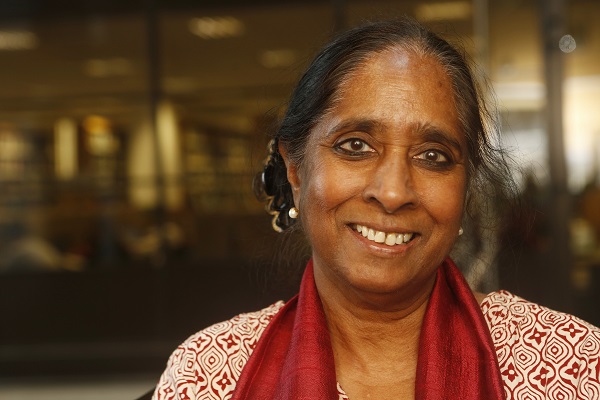
As we witness the daily brutality of public violence in the news cycle, the ongoing horror of violence in millions of homes globally remains unseen. Public acts of violence often spark emotions and incite us to action. How can we make sure that this response is extended to acts of violence inflicted behind doors? Domestic violence, mostly in the home and experienced by women from a partner, is embedded in cultures across the globe. Because it is not ‘visible’, this daily violence is perceived as the private problem of individuals and not necessarily an unacceptable brutality that impacts us all.
In fact, domestic violence is the issue that underlies the manifestation of violence in the public space from crime to war and terrorism. To neglect the wider problem of domestic violence is to neglect the conditions for public violence. Just as we condemn the brutality of war, and the sexual violence which often accompanies it, we must also take action to fight the daily violence against women in our homes and communities.
Research has shown a strong association between high levels of domestic violence and higher levels of general crime. A key pathway is that male perpetrators of intimate partner violence are more likely to engage in substance abuse, exhibit anti-social behaviour and engage in sexual promiscuity, all essential aspects of toxic masculine norms. Research has highlighted that young men and women who witness or experience violence within the family are more likely to engage in anti-social behaviour, substance abuse, and gang membership. Unsurprisingly, a US study suggests that 23 to 79% of violent youths and violent offenders had come from homes in which intimate partner violence had occurred. (1)
An equally strong link has been made between domestic violence and violence in the public space such as mass shootings and terrorist acts. In the US, where mass shootings are a frequent occurrence, recent research indicates that between 2014 and 2019, perpetrators in a majority of mass shootings (68%) had a history of domestic violence, and/or had killed a partner or family member just preceding or during the mass shooting.(2) A similar commonality has been found among those who have perpetrated recent terrorist incidents in Nice and Florida in 2016. Radicalised youth, and young men in particular, share one common factor in their journey of radicalisation – domestic violence in the family. Extreme right or extreme left, fundamentalists of various stripes share this background. A recent study from the UK examined the histories of men referred to the counter terrorism policing (CTP) unit. Project Starlight reviewed a sample of 3,045 individuals referred to the unit in 2019 and found that just over a third (1,076) had a link to a domestic abuse incident – either as an offender, victim, witness or a combination of all three. This research demonstrates clearly the link between misogyny, domestic violence and radicalisation.
The relationship between domestic violence and conflict is another area of exploration that expands our understanding of the ripple effects of domestic violence from the intimate space to the public square. Seminal research by feminist international studies scholars has highlighted the relationship between gender (in)equality and the likelihood of conflict, whether between states or within states. One of the first studies in this area argued that gender inequality is a significant predictor of the likelihood of conflict, as those states characterised by gender discrimination and structural hierarchy are permeated with norms of violence that make internal conflict more likely (Caprioli, 2005).
These tendencies are buttressed by the fact that many national identities prioritise female purity and male strength. The warrior male protecting the nation (embodied in its dependent/ vulnerable women and children) is a core part of the nationalist founding mythology across countries of the global North and South. The inherent misogyny in these foundational understandings of the nation state is also the basis for sexual violence which is an essential expression of social control of women. Sexual violence in conflict, and the particular use of sexual violence as a weapon of war, is not some natural phenomenon, but rooted in the overarching patriarchal norms that are predominant in peace times. Conflict, and the consequent destabilisation of social and legal frameworks, ensures virtually no accountability for sexual violence perpetrators. The firm stand taken to initiate prosecution of sexual violence perpetrators in the current Ukraine war, as it is unfolding, is a remarkable departure from usual practice, and holds promise that the culture of sexual violence will be forcefully addressed.
There is a notable parallel between the chaos of conflict and violence against women in the home (Clark et.al. 2010; Gupta et.al. 2010). A recent 2022 article on the Boko Haram insurgency in Nigeria indicates that women and girls living in areas of insurgency had significantly higher levels of violence perpetrated in the home than areas not affected. This has been seen in earlier conflicts in Georgia, and Ukraine. Still, the discussion of domestic violence remains absent in the current coverage of global conflicts. We must place plans to address domestic violence alongside justice for sexual violence survivors, at the centre of discussions to develop a gender-aware process of rebuilding post-conflict societies.
Patriarchal norms, and consequent gendered power imbalances in the home, fuel domestic violence against women and girls. While domestic violence impacts individuals of all genders, misogyny plays a vital role in the majority of cases. It is imperative that we address these norms if we truly want to translate gender equality aspirations into reality. It is time that misogyny is confronted where it first originates – in the home. The recent uproar regarding sexual harassment and bullying in Westminster, for example, posits misogyny as something mysterious that permeates institutions and society more broadly, with no foundation. And yet, evidence shows us that this is familiar behaviour, beginning in our homes. Domestic violence is the wellspring of the various manifestations of violence across the different spaces of society. We need to change the conversation to account for the enormity of domestic violence inflicted on women, and to underscore the patriarchal foundations of misogynistic acts. Addressing male violence in the home is the first step needed to move towards a genuine architecture of gender equality.
(1) Widom, C.Z. and Wilson, H.W. (2015). ‘Intergenerational transmission of Violence’ in Lindert, J. and Levav, I. (eds) Violence and Mental Health: Its Manifold Faces Springer Dordrecht, https://doi.org/10.1007/978-94-017-8999-8.
(2) Geller LB, Booty M, Crifasi CK. ‘The role of domestic violence in fatal mass shootings in the United States, 2014-2019.’ In J Epidemiol. 2021 May 31;8(1):38. doi: 10.1186/s40621-021-00330-0. PMID: 34053458; PMCID: PMC8165999.
Learn more about research in domestic violence (DV) at University of Galway in the research impact case study, “Domestic Violence: The Cost of Doing Nothing”.
Profiles

Nata Duvvury is Senior Lecturer and Director, Centre for Global Women’s Studies and Co-Leader of Gender and Public Policy Cluster in the Whitaker Institute at National University of Ireland, Galway. Dr. Nata Duvvury is an international development expert with more than 25 years of experience in gender, development and empowerment. Her work includes research and advocacy on gender-based violence, women’s property rights, and HIV and AIDS in a variety of settings including conflict and post-conflict contexts.
Dr Duvvury's groundbreaking work on the costs of violence against women has gained international recognition, cited by Hilary Clinton, Mary Robinson, World Bank economist Caren Grown, by UN Women, and international donor agencies and cited in numerous journal articles.